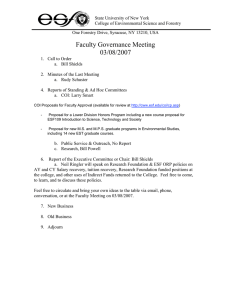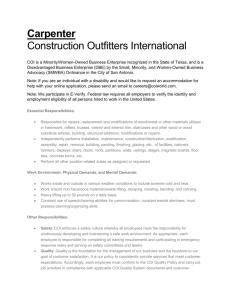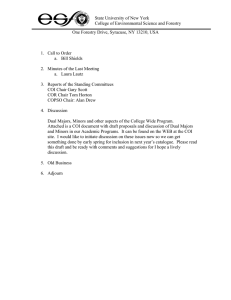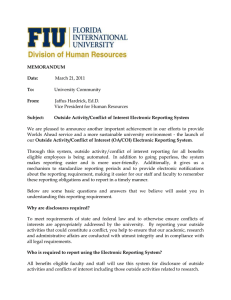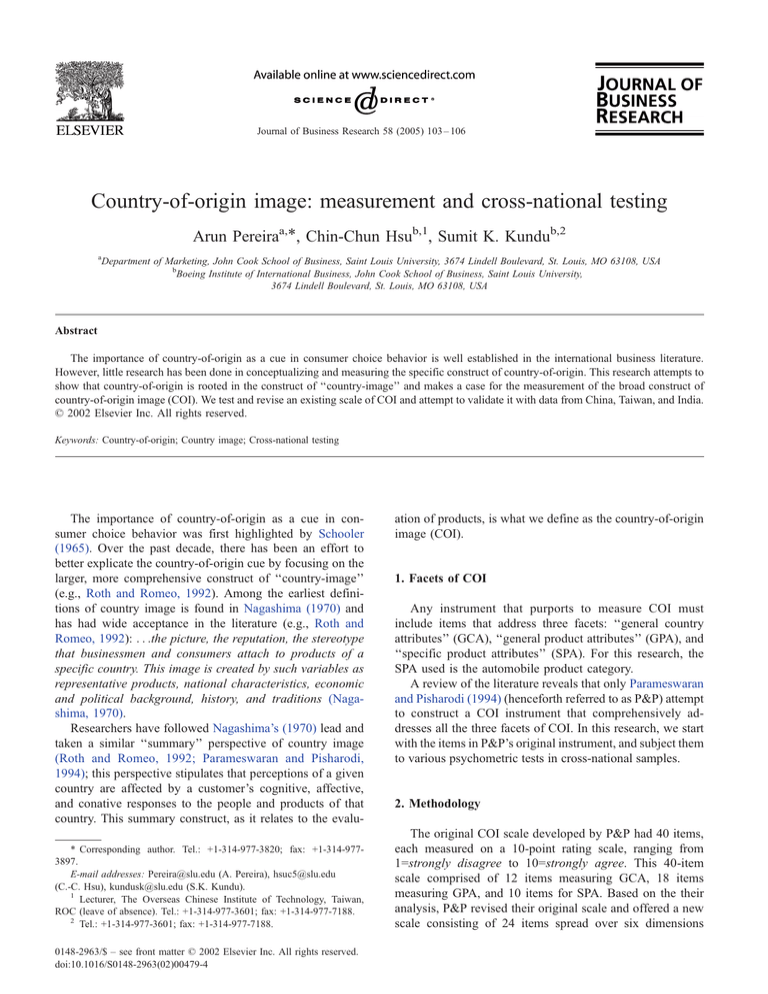
Journal of Business Research 58 (2005) 103 – 106
Country-of-origin image: measurement and cross-national testing
Arun Pereiraa,*, Chin-Chun Hsub,1, Sumit K. Kundub,2
a
Department of Marketing, John Cook School of Business, Saint Louis University, 3674 Lindell Boulevard, St. Louis, MO 63108, USA
b
Boeing Institute of International Business, John Cook School of Business, Saint Louis University,
3674 Lindell Boulevard, St. Louis, MO 63108, USA
Abstract
The importance of country-of-origin as a cue in consumer choice behavior is well established in the international business literature.
However, little research has been done in conceptualizing and measuring the specific construct of country-of-origin. This research attempts to
show that country-of-origin is rooted in the construct of ‘‘country-image’’ and makes a case for the measurement of the broad construct of
country-of-origin image (COI). We test and revise an existing scale of COI and attempt to validate it with data from China, Taiwan, and India.
D 2002 Elsevier Inc. All rights reserved.
Keywords: Country-of-origin; Country image; Cross-national testing
The importance of country-of-origin as a cue in consumer choice behavior was first highlighted by Schooler
(1965). Over the past decade, there has been an effort to
better explicate the country-of-origin cue by focusing on the
larger, more comprehensive construct of ‘‘country-image’’
(e.g., Roth and Romeo, 1992). Among the earliest definitions of country image is found in Nagashima (1970) and
has had wide acceptance in the literature (e.g., Roth and
Romeo, 1992): . . .the picture, the reputation, the stereotype
that businessmen and consumers attach to products of a
specific country. This image is created by such variables as
representative products, national characteristics, economic
and political background, history, and traditions (Nagashima, 1970).
Researchers have followed Nagashima’s (1970) lead and
taken a similar ‘‘summary’’ perspective of country image
(Roth and Romeo, 1992; Parameswaran and Pisharodi,
1994); this perspective stipulates that perceptions of a given
country are affected by a customer’s cognitive, affective,
and conative responses to the people and products of that
country. This summary construct, as it relates to the evalu* Corresponding author. Tel.: +1-314-977-3820; fax: +1-314-9773897.
E-mail addresses: Pereira@slu.edu (A. Pereira), hsuc5@slu.edu
(C.-C. Hsu), kundusk@slu.edu (S.K. Kundu).
1
Lecturer, The Overseas Chinese Institute of Technology, Taiwan,
ROC (leave of absence). Tel.: +1-314-977-3601; fax: +1-314-977-7188.
2
Tel.: +1-314-977-3601; fax: +1-314-977-7188.
0148-2963/$ – see front matter D 2002 Elsevier Inc. All rights reserved.
doi:10.1016/S0148-2963(02)00479-4
ation of products, is what we define as the country-of-origin
image (COI).
1. Facets of COI
Any instrument that purports to measure COI must
include items that address three facets: ‘‘general country
attributes’’ (GCA), ‘‘general product attributes’’ (GPA), and
‘‘specific product attributes’’ (SPA). For this research, the
SPA used is the automobile product category.
A review of the literature reveals that only Parameswaran
and Pisharodi (1994) (henceforth referred to as P&P) attempt
to construct a COI instrument that comprehensively addresses all the three facets of COI. In this research, we start
with the items in P&P’s original instrument, and subject them
to various psychometric tests in cross-national samples.
2. Methodology
The original COI scale developed by P&P had 40 items,
each measured on a 10-point rating scale, ranging from
1=strongly disagree to 10=strongly agree. This 40-item
scale comprised of 12 items measuring GCA, 18 items
measuring GPA, and 10 items for SPA. Based on the their
analysis, P&P revised their original scale and offered a new
scale consisting of 24 items spread over six dimensions
104
A. Pereira et al. / Journal of Business Research 58 (2005) 103–106
(GCA1, GCA2, GPA1, GPA2, GPA3, and SPA). See Appendix A for P&P’s original and revised scales.
For this research, data were collected form three countries:
Taiwan (n=135), China (n=129), and India (n=111). In each
country, the respondents were graduate business students.
During data collection, all respondents rated the P&P’s
original 40-item instrument twice: the first measured the
COI of USA (and US automobile) and the second, the COI
of Germany (and German automobile). As such, two sets of
data were generated from each respondent.
The following three steps are used in our analysis. Step 1:
Assess the validity of P&P’s revised COI instrument. Step 2
(if needed; if not, proceed to Step 3): Purify the instrument
using item analysis (including item to item and item to total
correlation), and factor analysis (including exploratory factor analysis and confirmatory factor analysis [CFA]). Step 3:
Test the instrument across multiple countries using structural equations modeling (SEM) and complete a crossnational analysis.
3. Results
Step 1: To test P&P’s instrument, confirmatory factory
analysis was performed with data from Taiwan (n=135). The
LISREL results were poor (the goodness-of-fit [GFI]=.072
and adjusted goodness-of-fit [AGFI]= .048).
Step 2: The following three steps were attempted to
‘‘purify’’ the 40-item instrument and generate a ‘‘purified’’
primary model (a) reliability test, (b) item analysis, and (c)
validity test. The data used were the Taiwanese responses to
Germany and a German-made car. Once the ‘‘purified’’
model was generated, it was retested using the Taiwanese
responses to US and a US-made car.
(a) Reliability test: we tested internal consistency reliability and in general, coefficient a’s were satisfactory,
ranging between .73 and .93. (b) Item analysis: item-score
to scale-score correlations were computed (scale-score
obtained by computing the arithmetic average of the scores
across all items). Items with correlations less than .50 were
deleted. This resulted in the deletion of two items in GCA,
five items in GPA, and two items in SPA. (c) Validity test:
principal components analysis was performed to identify
the factorial structure of the scale. Only factors with
eigenvalues greater than 1 were retained and items with
factor loading less than .5 were deleted. In the case of
GCA, two factors with eigenvalues greater than 1 explained
63% of the variance. One item was deleted in this stage.
This result is consistent with that of P&P. For GPA, an
orthogonal (varimax) rotated solution generated two factors, which explained 59% of the variance. Four items were
deleted in this stage. For SPA, one factor was retained and
it explained 59% of the variance. Three items were deleted.
These results are also consistent with that of P&P. In
summary, the initial results from exploratory factor analysis
generated the following primary model: GCA with two
factors (namely, GCA1 and GCA2 with eight items), GPA
with two factors (namely, GPA1 and GPA2 with nine
items), and SPA with one factor (namely, SPA1 with five
items).
To evaluate the overall fit of the data to the model, CFA
was conducted using LISREL VIII (Joreskog and Sorbom,
1996). The measurement model, as described above, has
five dimensions measured by 22 variables. To start with,
CFA found all 22 items to be statistically significant. At
this point, the overall fit of the model suffered. Several
problems hindered the model fit. First, high factor loading
correlations existed between items within factors. Second,
several large standardized residuals were found between
items, indicating high correlations among the error terms
(Gerbing and Anderson, 1984). During the process of
evaluating several iterations of CFA, six problematic items
were deleted from the model. The adjusted model contained 5 dimensions with 16 items.
The results (see the first column in Table 1) show that the
difference between the GFI and AGFI is .050 (GFI=.90,
AGFI=.85). These indices indicate good model fit, as does
the results of the chi-square test. Further, results of the
measurement model indicate that all paths in the model are
statistically significant assuring that the exogenous variables
are being measured properly by their respective variables.
Testing the ‘‘purified’’ model : In this step, the second set
of Taiwanese responses (to the US and a US-made car) were
subject to CFA to confirm the above model (5 dimensions,
16 variables). The results (see the fourth column in Table 1)
indicate that difference between GFI and AGFI was .050
(GFI=.89, AGFI=.84). The root mean square residual
(RMSR) value was .057 and the ratio of chi-square to
degrees of freedom was 1.43. Further, comparative fit index
(CFI) of .92 and the incremental fit index (IFI) of .93 also
show an adequate model fit.
In summary, the results of CFA provide evidence that we
have a satisfactory model. See Appendix A for the final list
of dimensions and items that make up this model.
Step 3: Data from China and India (in addition to
Taiwan) were used to test our ‘‘purified’’ model of COI.
Table 1
LISREL results
c2
df
P-value
c2/df
RMSEA
GFI
AGFI
NFI
NNFI
CFI
IFI
COI (Germany, German car)
COI (US, US car)
Taiwan
(n=135)
China
(n=129)
India
(n=111)
Taiwan China
India
(n=135) (n=129) (n=111)
124.44
94
.07386
1.32
.049
.90
.85
.86
.94
.95
.96
165.52
94
.00004
1.76
.073
.87
.81
.77
.83
.87
.87
153.96
94
.00001
1.63
.076
.85
.78
.81
.88
.90
.91
134.93
94
.00364
1.43
.057
.89
.84
.81
.90
.92
.93
109.50
94
.13103
1.16
.036
.90
.86
.79
.95
.96
.96
214.54
94
.00000
2.28
.108
.80
.72
.72
.75
.80
.81
A. Pereira et al. / Journal of Business Research 58 (2005) 103–106
Table 1 provides the results of the cross-national testing.
The first three columns of Table 1 report results of data on
COI of Germany (and German car) and the last three
columns of Table 1 report results of data on US (and US
car). As seen in the case of US and US-made car, the data
from China moderately fit the five-factor measurement
model with c2 /df=1.76, RMSEA=.073, NFI=.77,
NNFI=.83, and CFI=.87. Coefficient a’s ranged from .71
to .98 for the five subscales. The data from India also showed
a moderate fit with the measurement model, as evidenced by
c2 /df=1.63, RMSEA=.076, NFI=.81, NNFI=.88, and
CFI=.90. Coefficient a’s for the five subscales ranged from
.68 to .94.
In the case of US and US-made car, the Chinese data
strongly supported the five-factor model with a nonsignificant chi-square value (c2=109.50, P=.13, c2/df=1.16,
RMSEA=.036, NFI=.79, NNFI=.95, and CFI=.96). Coefficient a’s ranged .77 –.95 for the five subscales. However,
105
the data from India did not fit the measurement model well.
The analysis of the India sample resulted in a disproportionately large value of the ratio of chi-square to degrees of
freedom and RMSEA greater than .80, accompanied by
inappropriate fit indices values.
4. Conclusion
The results of this study reveal that the revised version
of P&P’s COI scale, in the form of a 16-item, 5-factor
measure can be usefully applied to help understand COI of
products entering certain Asian countries, such as Taiwan
and China. However, the validity of the COI scale was not
well established in the third Asian country, India. More
research is needed to identify if there are other countries
like India that may require additional modifications to the
COI measure.
Appendix A
Parameswaran and Pisharodi (1994)
(a) GCA
Original
Results of present study
Revised (2 dimensions)
(2 dimensions)
Well-educated
Hard working
Hard working
Achieving high standards
Achieving high standards
Achieving high standards
Raised standard of living
Raised standard of living
Raised standard of living
Technical skills
Technical skills
Friendly and likable
Artist and creative
Well-educated
Hard working
Technical education
Technical skills
Similar political views
Similar political views
Similar political views
Economically similar
Economically similar
Economically similar
Culturally similar
Participates in international affairs
Culturally similar
Culturally similar
GCA1 (5 items)
GCA2 (3 items)
GCA1 (4 items)
GCA2 (3 items)
(b) GPA
(Original)
Revised (3 dimensions)
(2 dimensions)
Unreasonably expensive
Luxury products
Meticulous workmanship
Imitations
Imitations
Known mainly for
industry products
Sold in many countries
Sold in many countries
Not attractive
Intensely advertised
Not attractive
Frequent repairs
Frequent repairs
Not attractive
Intensely advertised
Frequent repairs
Wide range of models
Long lasting
Advertising informative
Long lasting
Long lasting
Advertising informative
(continued on next page)
106
A. Pereira et al. / Journal of Business Research 58 (2005) 103–106
Appendix A (continued)
Parameswaran and Pisharodi (1994)
Difficult to service
Cheaply put together
High technology
Results of present study
Difficult to service
Cheaply put together
Good value
Good value
Easily available
Easily available
Prestigious products
Prestigious products
GPA1 (5 items)
(c) SPA (automobile)
(Original)
Good fuel economy
GPA2 (4 items)
Revised (1 dimension)
(1 dimension)
Workmanship good
Handles well
Little maintenance
Workmanship good
Handles well
Exterior styling attractive
Workmanship good
Handles well
Little maintenance
GPA3 (3 items)
Prestigious product
GPA1 (2 items)
GPA2 (2 items)
Exterior styling attractive
Very comfortable
Very comfortable
Difficult to get parts
Quality service
Made to last
Made to last
Overall excellent
Overall excellent
SPA (4 items)
References
Gerbing DW, Anderson JC. On the meaning of within-factor correlated
measurement errors. J Consum Res 1984;11:572 – 80.
Joreskog KG, Sorbom D. LISREL8: user’s reference guide. Chicago, IL:
Scientific Software International; 1996.
Nagashima A. A comparison of Japanese and US attitudes toward foreign
products. J Mark 1970;34 (January):68 – 74.
SPA (5 items)
Parameswaran R, Pisharodi RM. Facets of country of origin image: an
empirical assessment. J Advert 1994;23 (March):43 – 61.
Roth MS, Romeo JB. Matching product category and country image perceptions: a framework for managing country-of-origin effects. J Int Bus
Stud 1992;23(3):477 – 97.
Schooler RD. Product bias in Central American common market. J Mark
Res 1965;3 (November):394 – 97.

